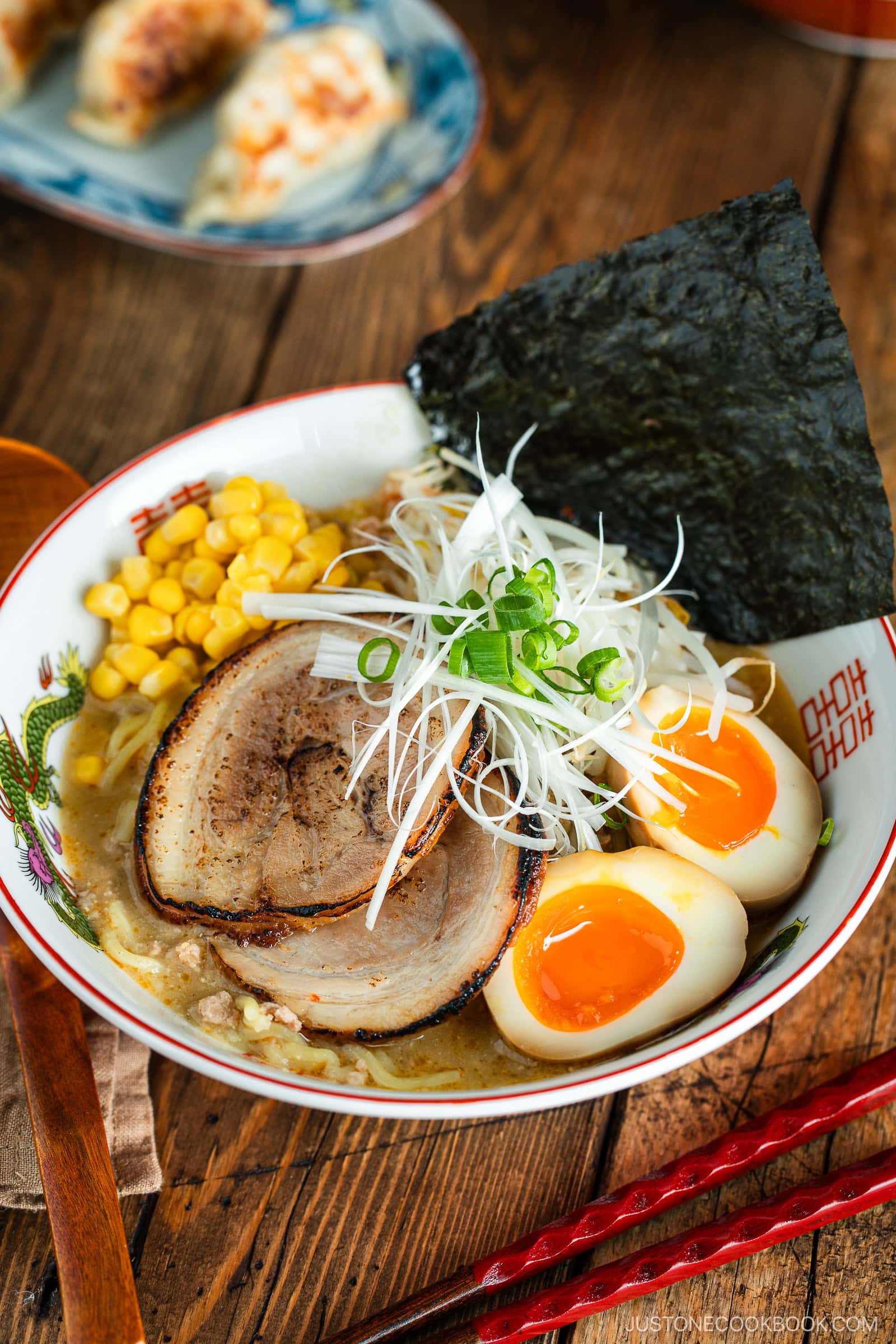
The next time you cook ramen at home, skip the instant kind and make my favorite Miso Ramen Recipe (味噌ラーメン) in less than 30 minutes. I’ll show you how to make a rich and delicious soup broth with a handful of ingredients. It beats spending hours to make it and tastes much better than any instant packet!
If you’re craving more Japanese noodles, try my Shio Ramen, Vegetarian Ramen, and Easy Tonkotsu Ramen Recipe next!
What is Miso Ramen?
Ramen is a Japanese adaptation of the Chinese noodle dish called lamian (拉麺). According to one theory, it arrived with the influx of Chinese immigrants to Yokohama, Kobe, Nagasaki, and Hakodate in the late Edo period (1603–1868). Meaning “pulled noodles,” ramen today comes in three basic flavors—salt, soy sauce, and miso. Miso ramen is thought to have originated in 1953 in Sapporo, Hokkaido.
Want to learn more about ramen? Continue reading Our Ramen Guide.

Why I Love This Recipe
- Quick and easy, packed with authentic flavor!
- No-fuss homemade ramen broth that’s rich and delicious.
- Customizable with your choice of vegetables and protein, and adaptable for vegan/vegetarian.
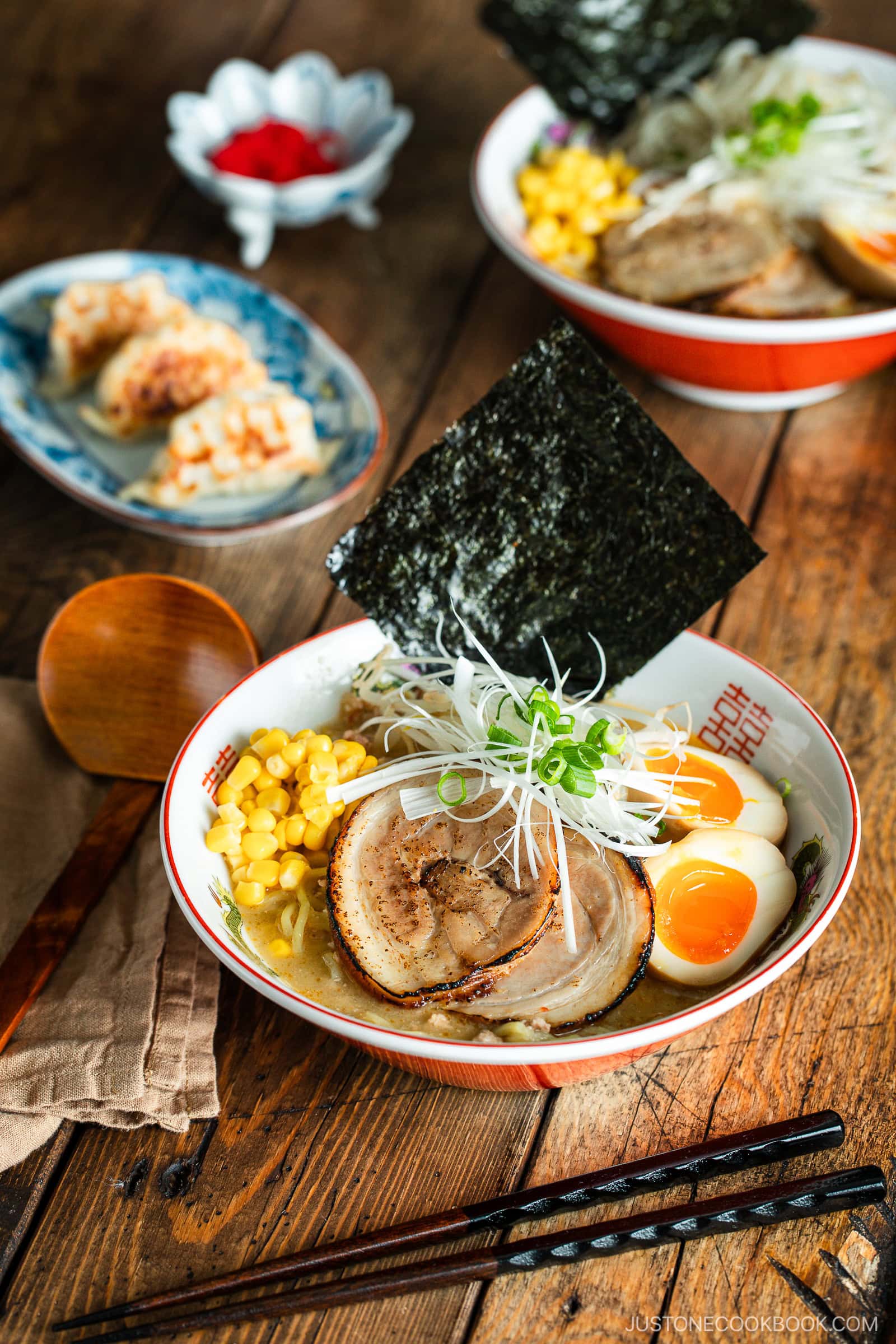
Ingredients for Miso Ramen
- fresh ramen noodles
- dark roasted sesame oil
- garlic cloves, fresh ginger, and shallot
- ground pork – or chopped mushrooms and meat alternatives for vegan/vegetarian
- doubanjiang (spicy chili bean paste)
- miso (Japanese fermented soybean paste) – use any miso except Hatcho or Saikyo
- toasted white sesame seeds
- chicken broth – or vegetable stock for vegan/vegetarian
- sake
- sugar, kosher salt, and white pepper powder
- toppings – I used Chashu, Ramen Egg, corn kernels, nori (dried laver seaweed), blanched bean sprouts, chopped green onions/scallions, and Shiraga Negi (julienned long green onions). You can read more about the ramen toppings here.
- condiments – I used la-yu (Japanese chili oil) for spice, pickled red ginger (beni shoga), and white pepper powder
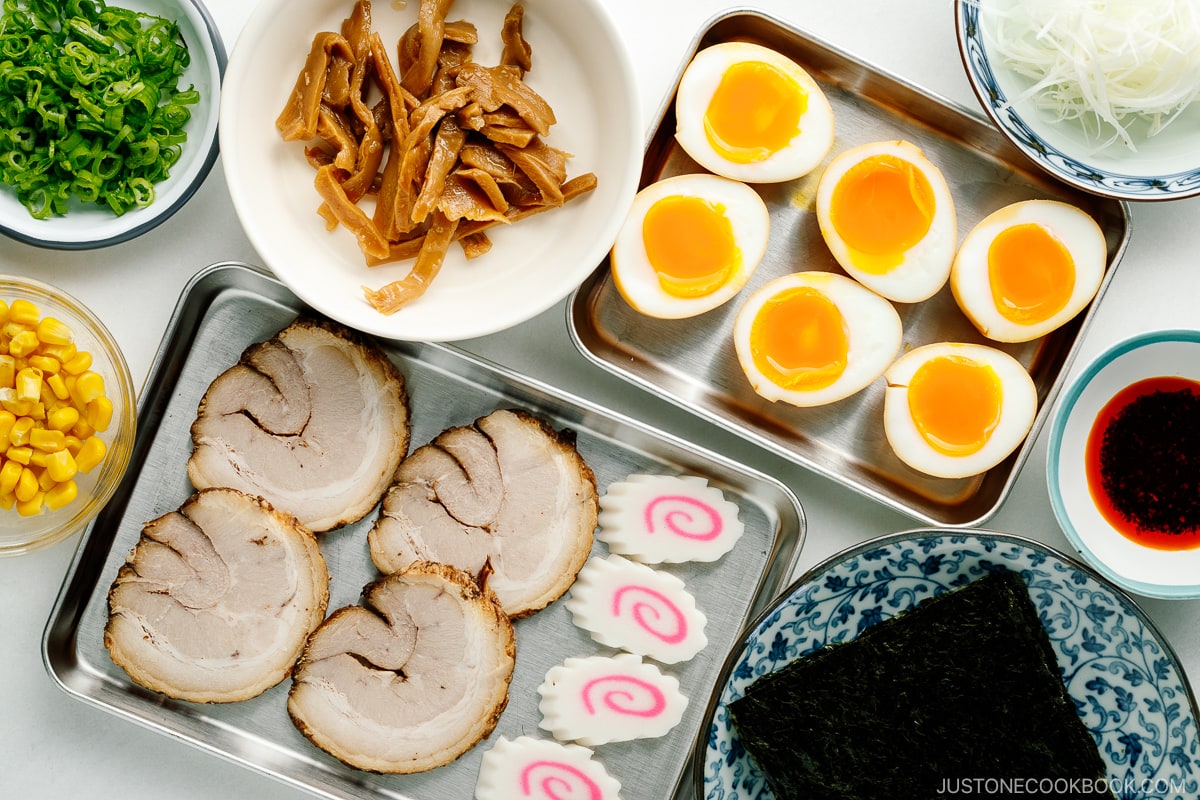
Find the printable recipe with measurements below.
Jump to RecipeSubstitutions
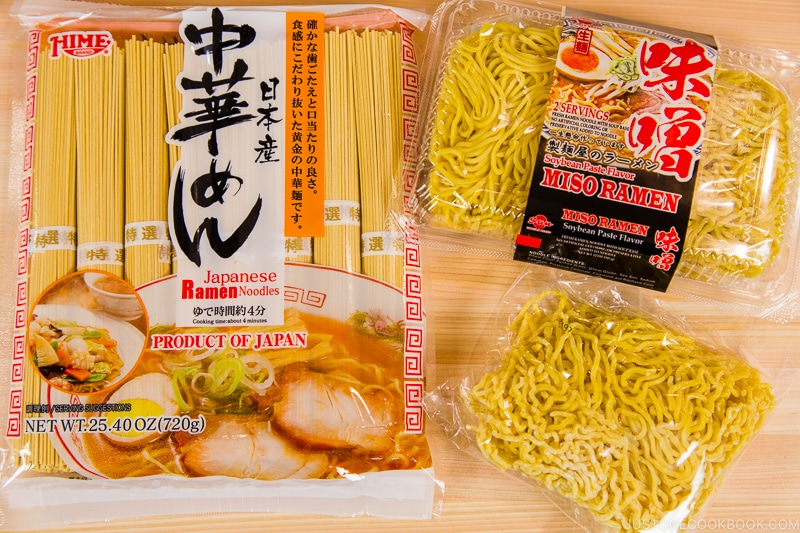
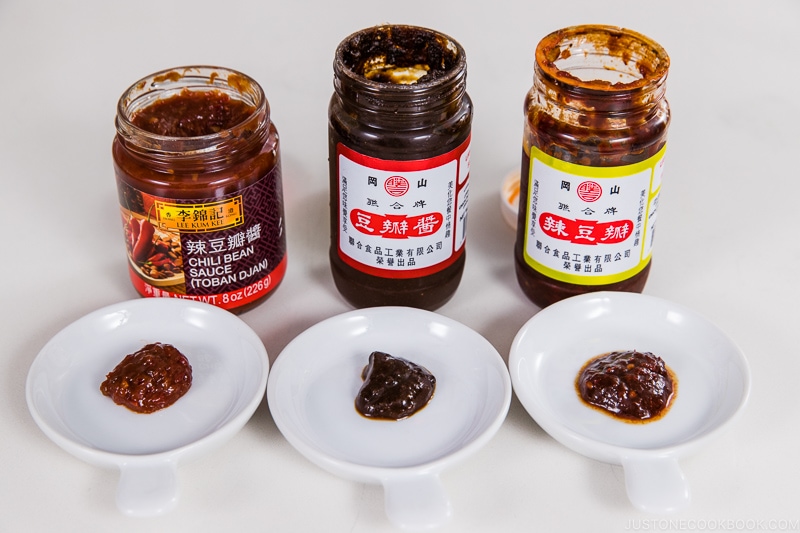
- ramen noodles: Use the fresh kind from the refrigerated section of Japanese and Asian grocery stores. My favorite brand is Sun Noodles. If you can’t find, use dried ramen noodles (chukamen). For a gluten free, try rice-based Kobayashi Seimen.
- doubanjiang: This Chinese bean paste adds incredible depth and character. It comes in spicy, non-spicy, and gluten-free varieties. I don’t recommend substituting with different types of condiments.
- dark roasted sesame oil: This dark type has the deepest flavor for a nuttier and richer broth, so please don’t substitute it.
How to Make Miso Ramen
- Prepare the aromatics and sesame seeds.
- Sauté the broth ingredients.
- Add the chicken stock, simmer and stir over medium heat, then season and keep warm.
- Cook the noodles in a large pot of boiling water until al dente.
- Serve the noodles, soup, and toppings in individual bowls and enjoy.
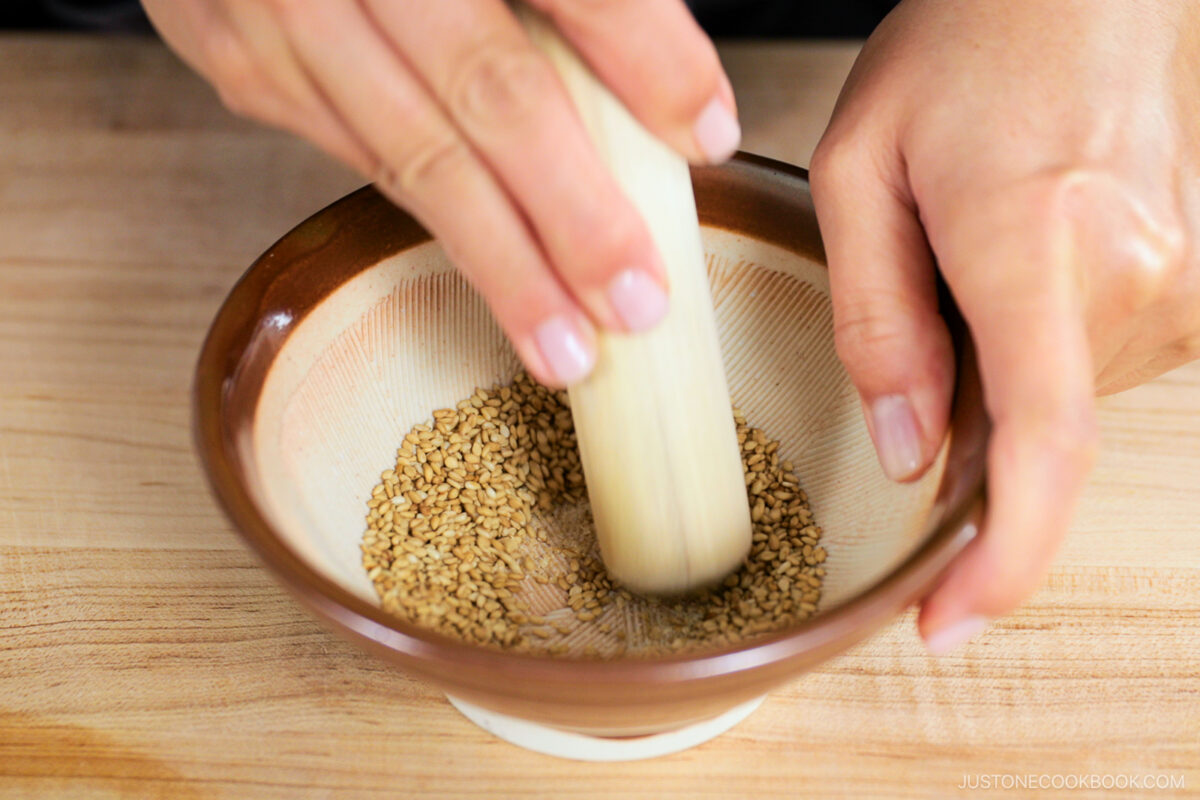
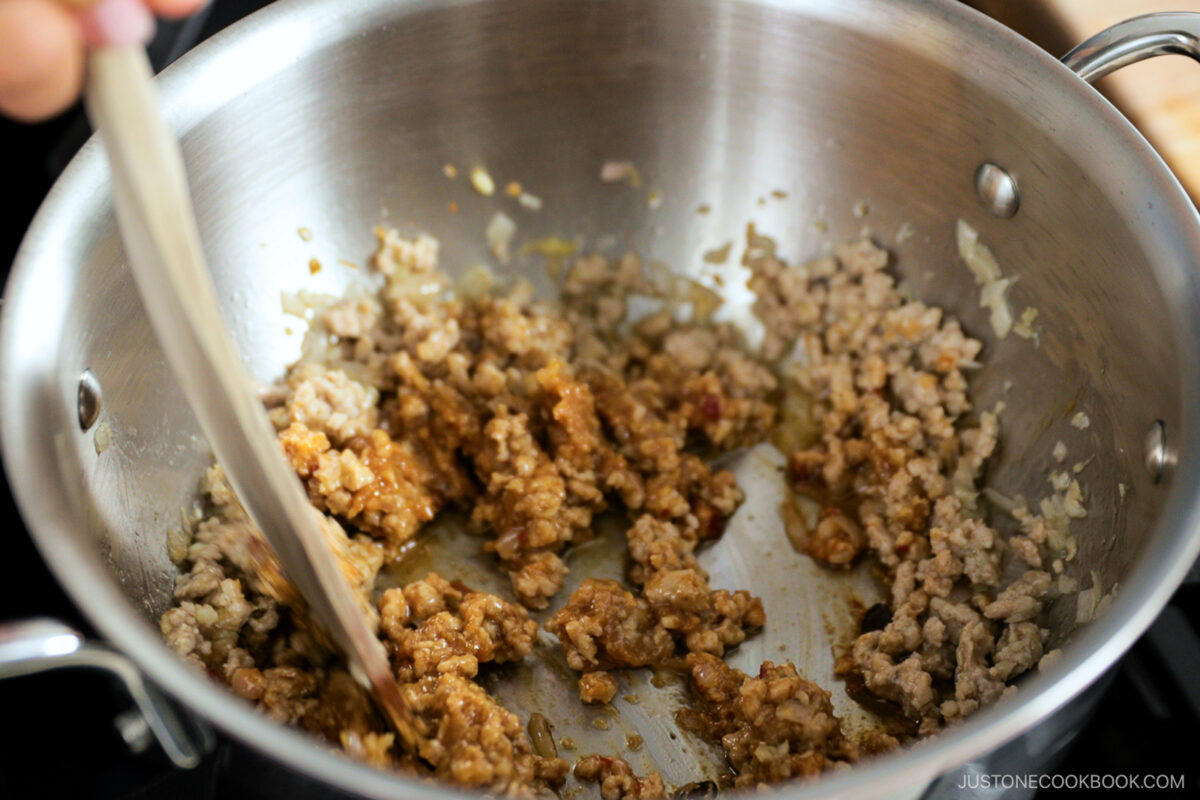
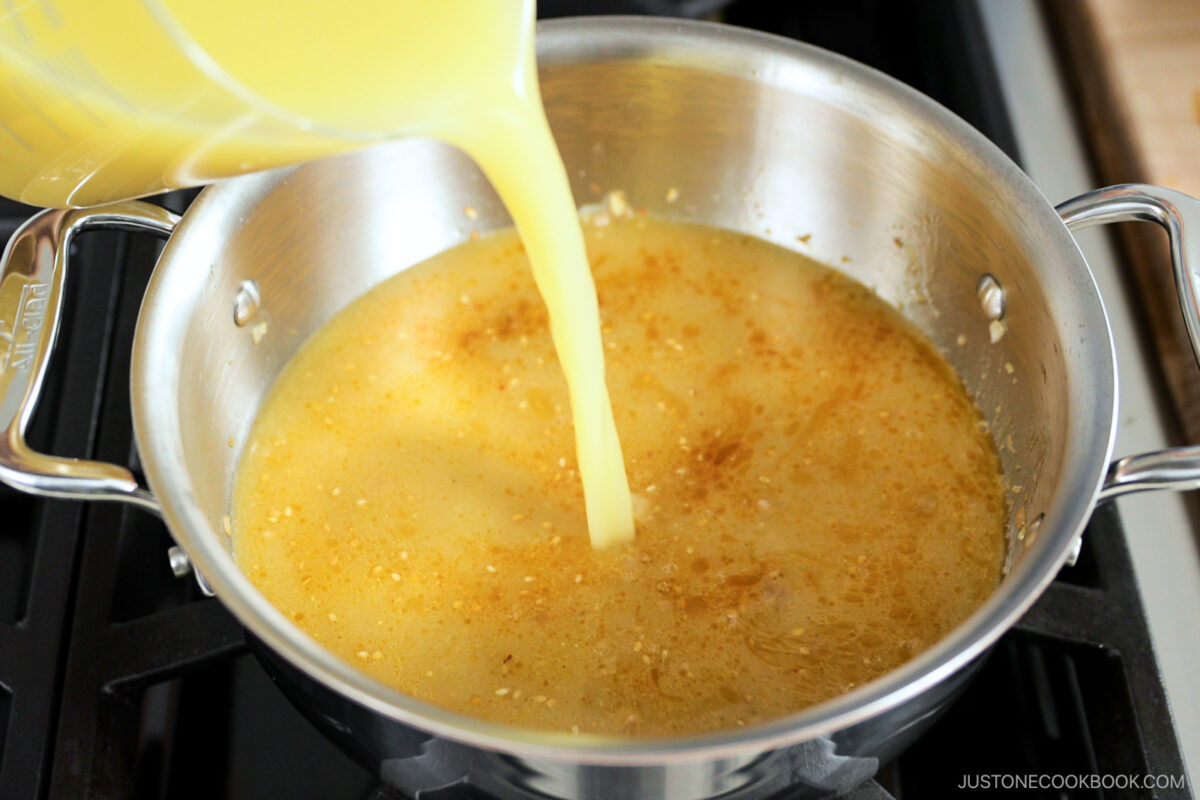
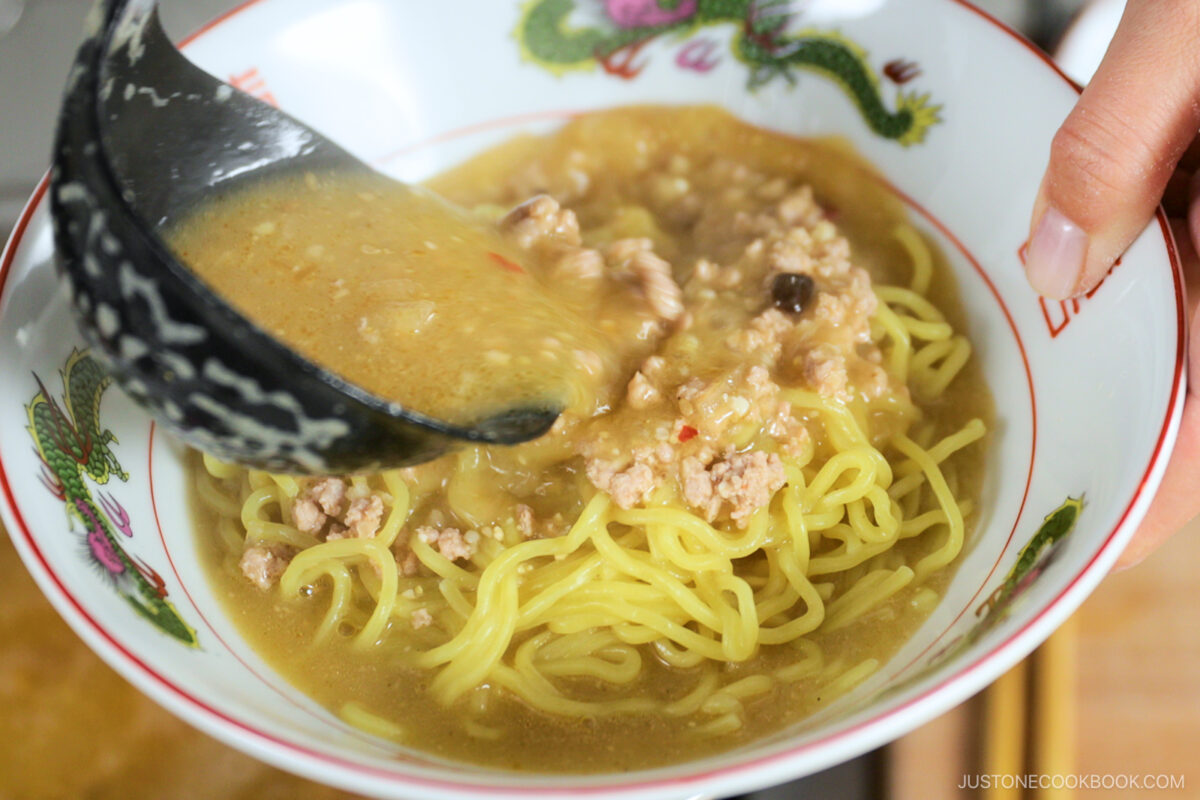
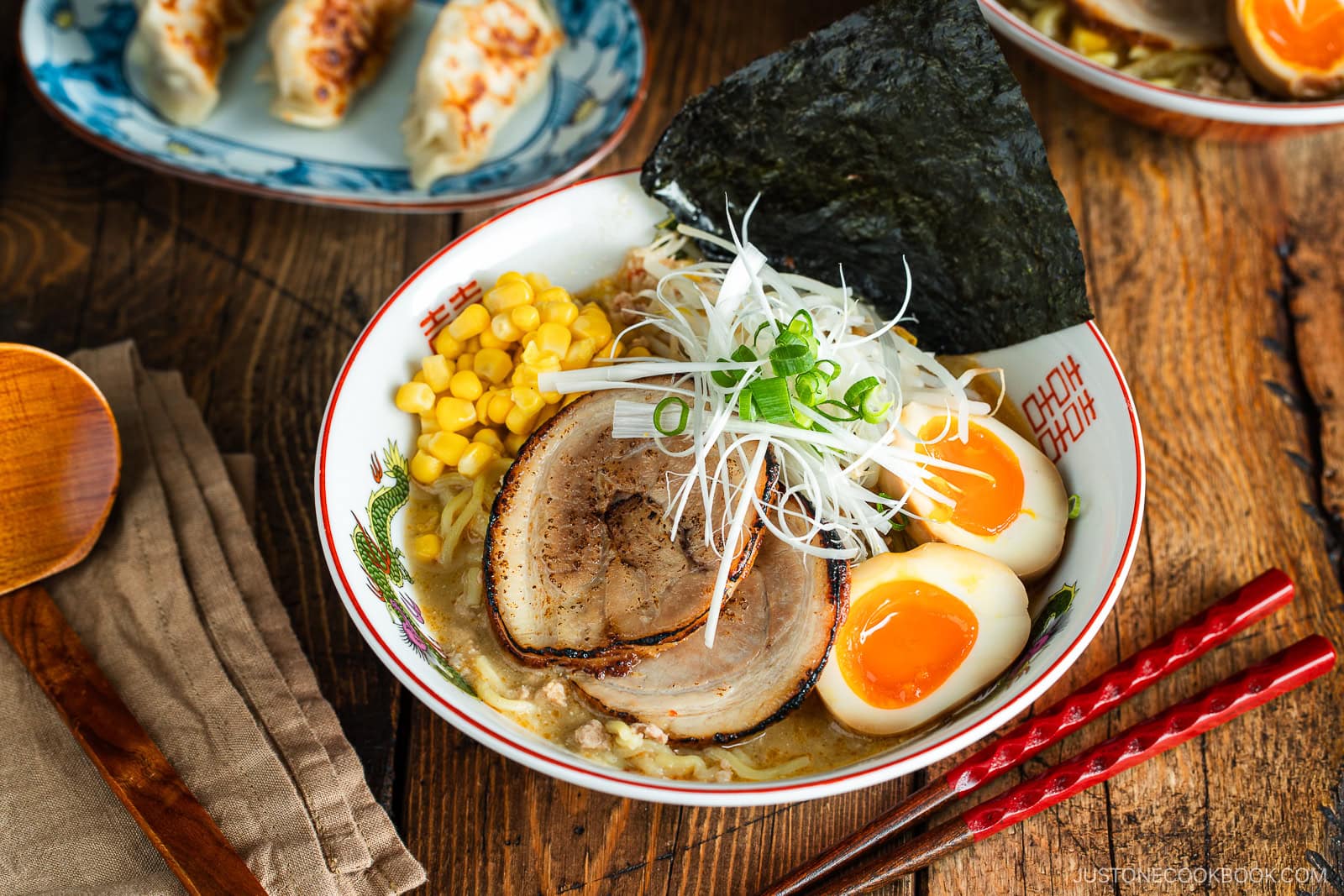
Nami’s Recipe Tips
- Prep toppings in advance, and you’ll spend only 30 minutes on the day you serve.
- Season after tasting to avoid over-salting, as each brand of chicken stock varies in saltiness.
- Use a large pot of boiling water so the noodles remain springy and don’t absorb excess starch.
- Gently loosen the noodles before boiling them so they cook evenly and don’t stick together.
- Boil just before serving. Ramen noodles cook fast, so be ready to serve in 30 seconds or less!
- Cook noodles al dente so they stay firm. For the brand I use, I boil them about 15 seconds less than the package instructions.
- Add texture with toppings. Try a mix of blanched bean sprouts, corn, chashu, ramen egg, and green onions for extra flavor and crunch.
- Enhance the aroma. A few drops of la-yu (chili oil) or a sprinkle of white pepper add incredible depth.
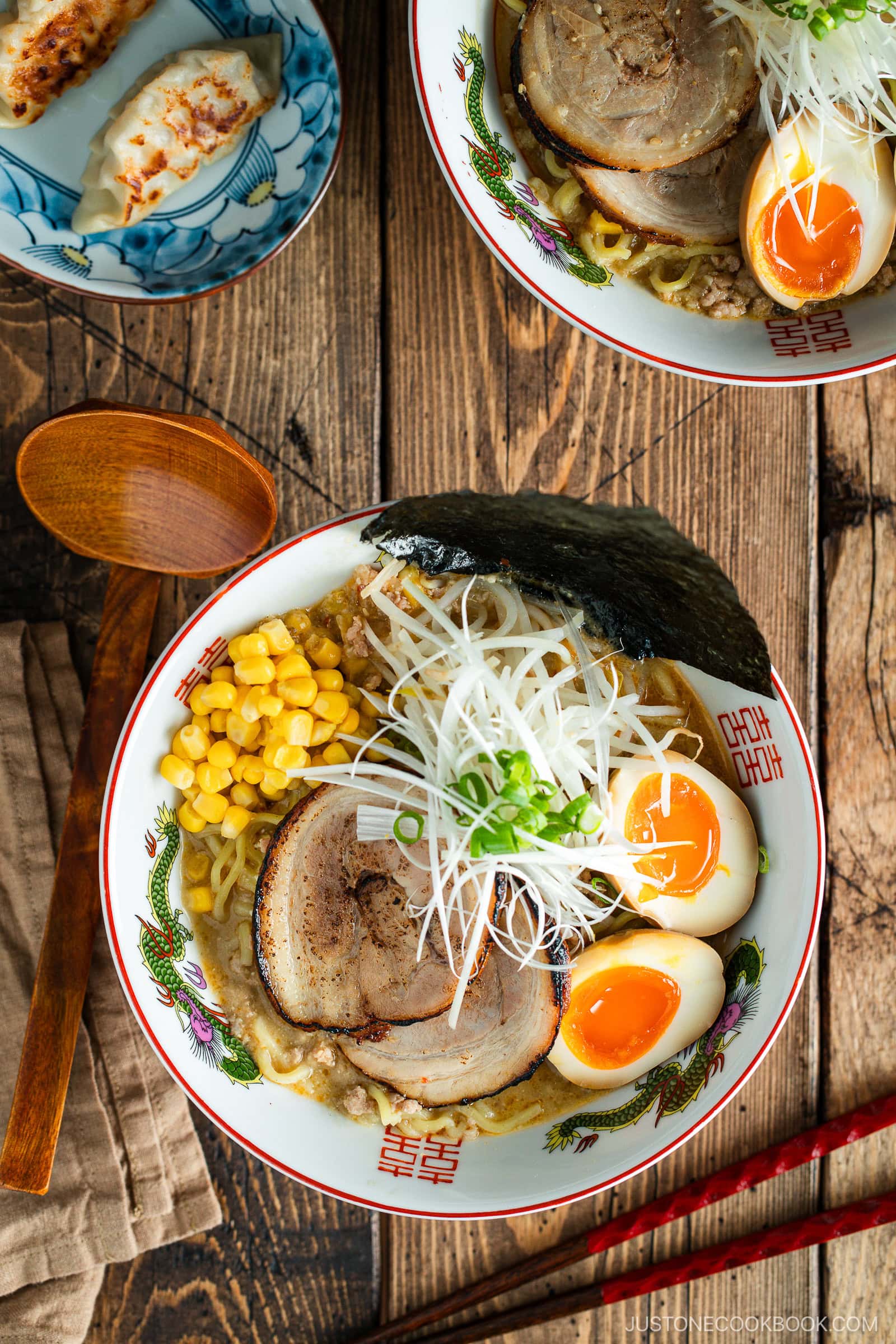
Variations and Customizations
- Adjust the heat level with non-spicy or spicy doubanjiang and chili oil, or skip it altogether.
- Swap Chicken Chashu for a quicker and lighter option.
- Try other toppings like menma (seasoned bamboo shoots), narutomaki (Japanese swirled fish cake), wakame seaweed, garlic chives, bok choy or spinach, tofu, or shiitake mushrooms.
- Add butter on top in thin slices (called Miso Butter Ramen)
- Make it vegetarian/vegan with vegetable stock, meat substitutes, or chopped mushrooms, and tofu.
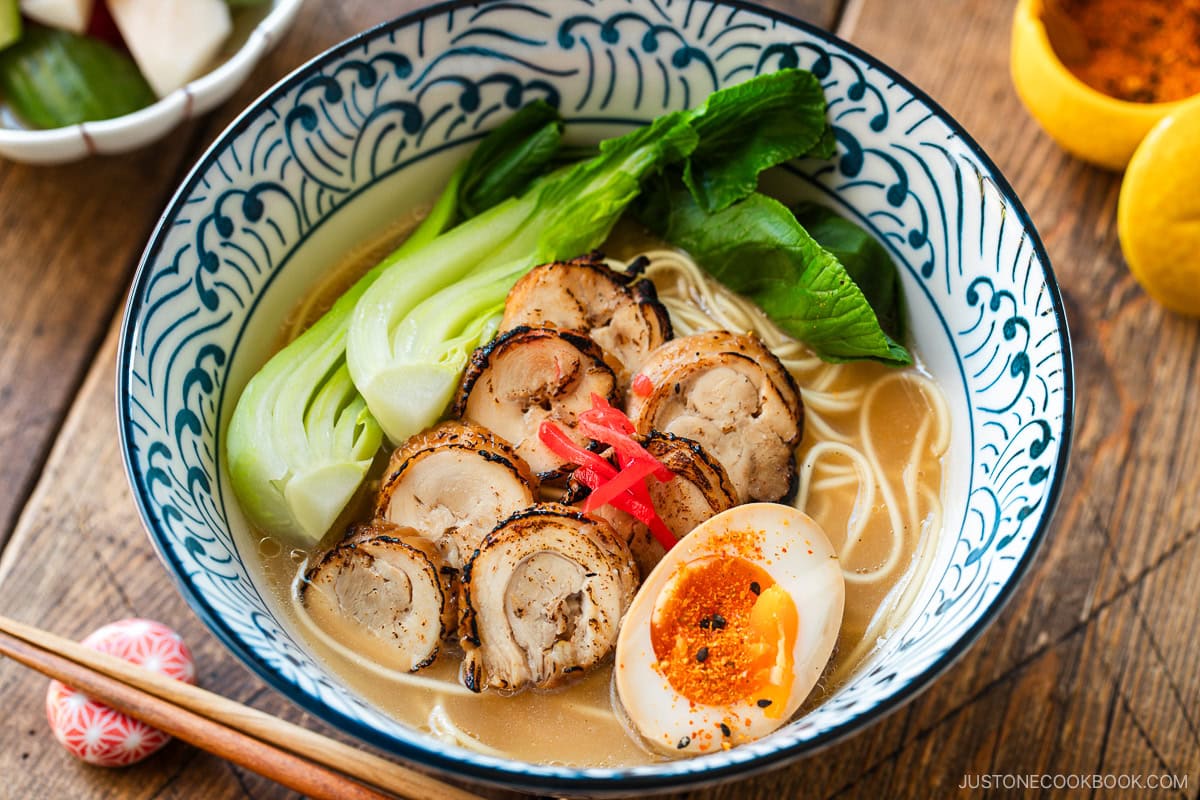
What to Serve with Miso Ramen
- With an appetizer – Edamame
- With a side dish – Gyoza (Japanese pan-fried dumplings)
- With a protein – Karaage (Japanese fried chicken)
- With a salad – Japanese Cucumber Salad
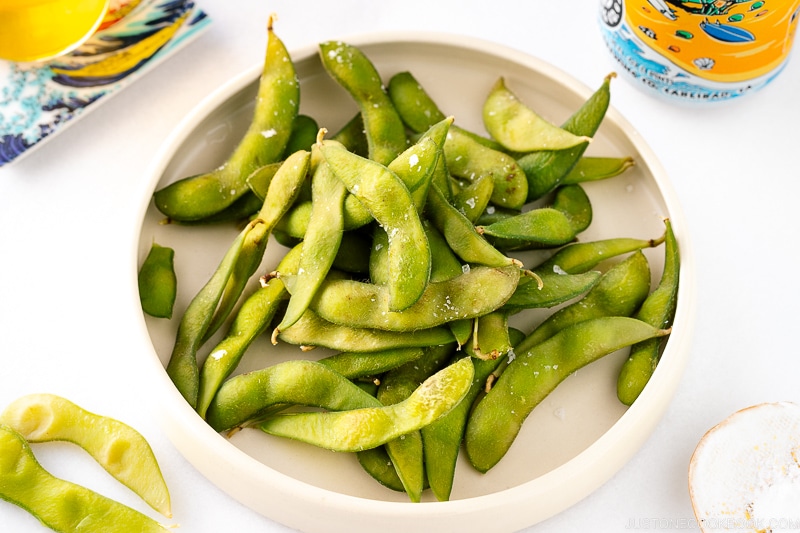
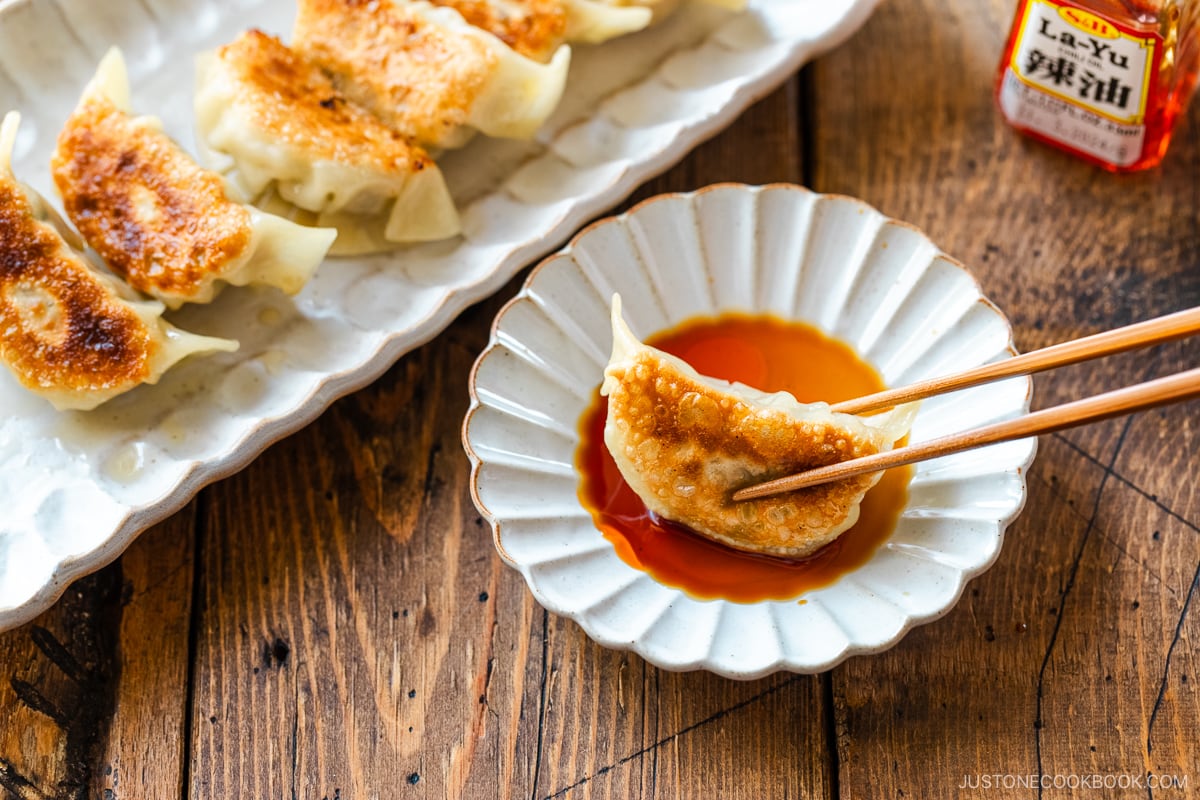
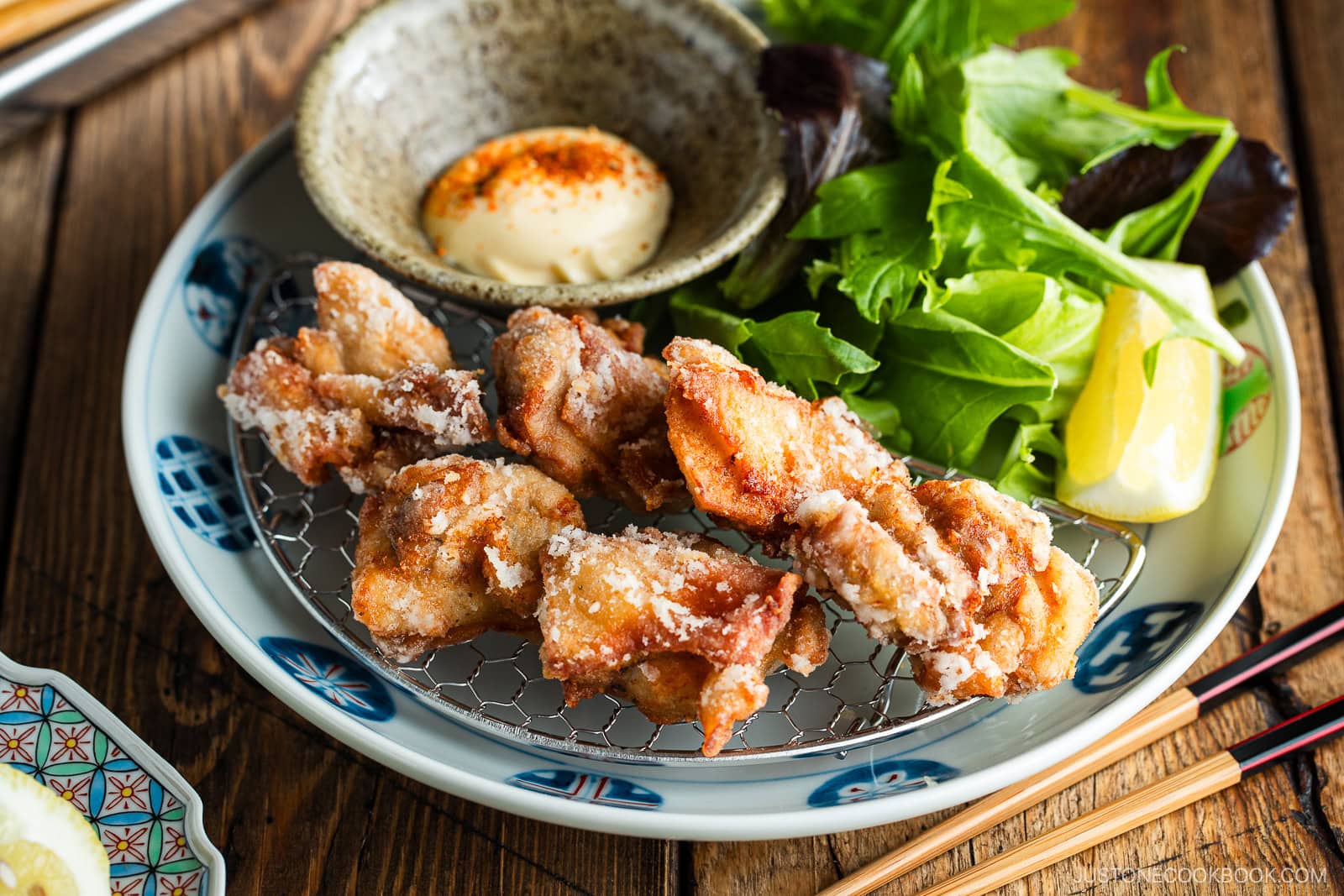
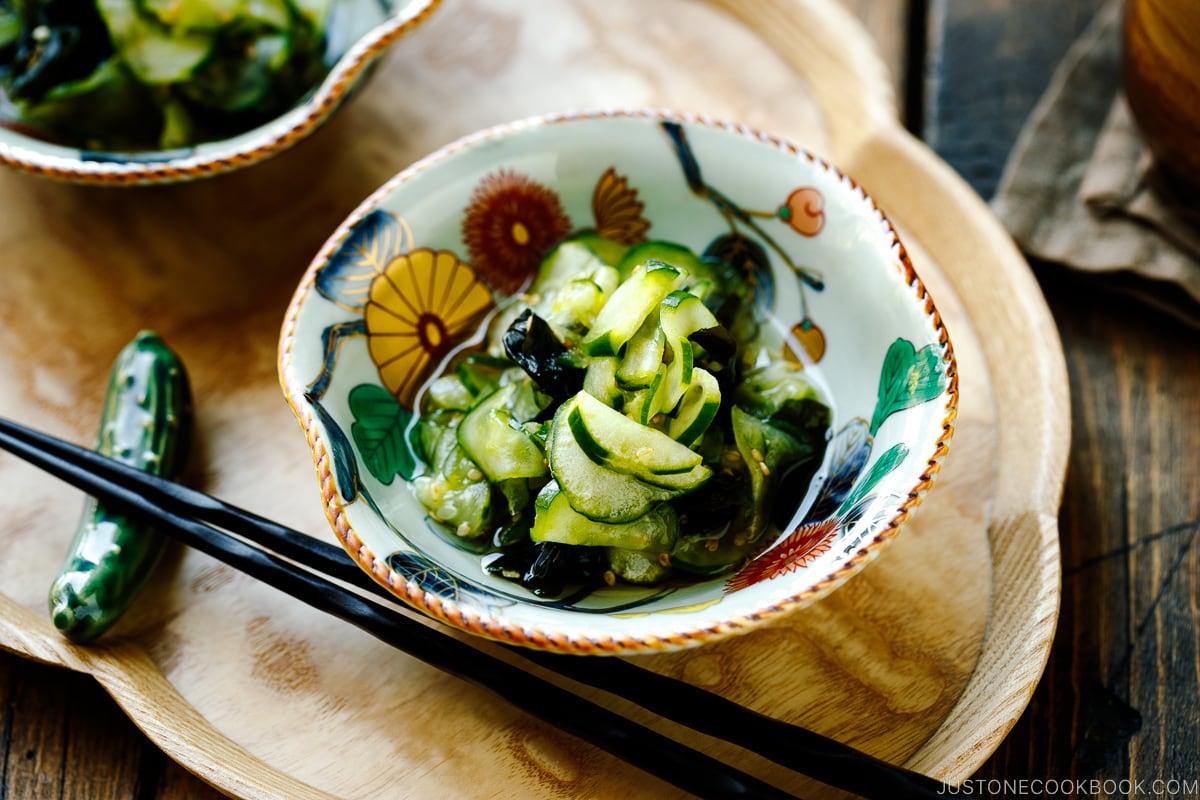
Storage Tips
To store: You can keep the soup broth in the fridge for 3 days. Cook the noodles right before serving.
Frequently Asked Questions
Do we need to add sugar?
Sugar balances the saltiness of the miso and doubanjiang (fermented bean paste). Add 1 teaspoon at a time, tasting as you go, until the flavor is just right.
Do we need to use sake?
Like soy sauce and mirin, sake is an essential ingredient in Japanese cooking. It helps remove any gamey smell from the meat while adding subtle sweetness and deep umami to the soup. If you don’t have sake, you can substitute dry sherry or Chinese rice wine.
I’d love to hear how yours turned out! 💛 Please leave a star rating and comment below to share your experience. Your feedback not only supports Just One Cookbook but also helps other home cooks discover recipes they can trust.
Before You Start
Prepare all the ramen toppings ahead of time—so they‘re ready to serve with your hot bowl of ramen.
If you're making Homemade Chashu (Japanese Braised Pork Belly) and Ramen Egg (Ajitsuke Tamago), start a day in advance.
Gather all the ingredients.
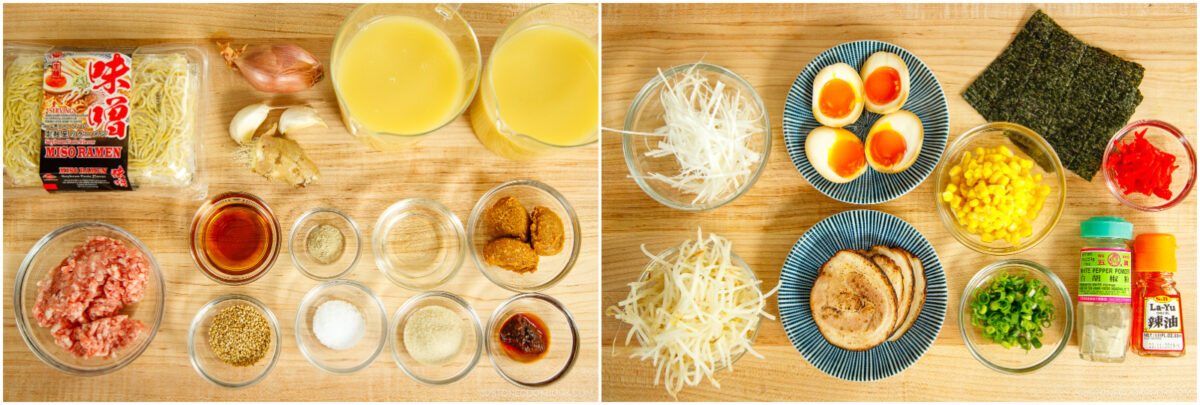
To Prepare the Soup Ingredients
Mince or press 2 cloves garlic (I use a garlic press) and add to a small plate. Then, grate the ginger (I use a ceramic grater) and add ½ tsp ginger (grated) to the plate.
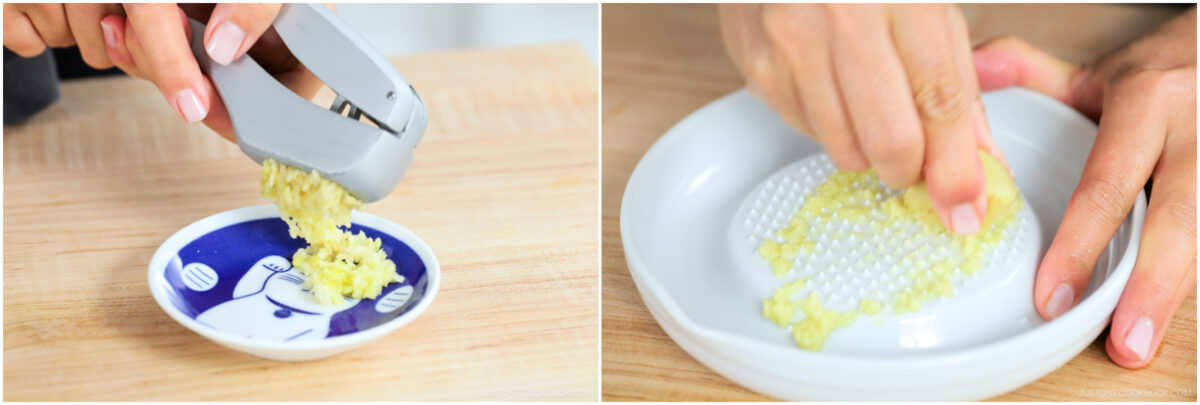
Mince 1 shallot and add to the plate. Set aside.
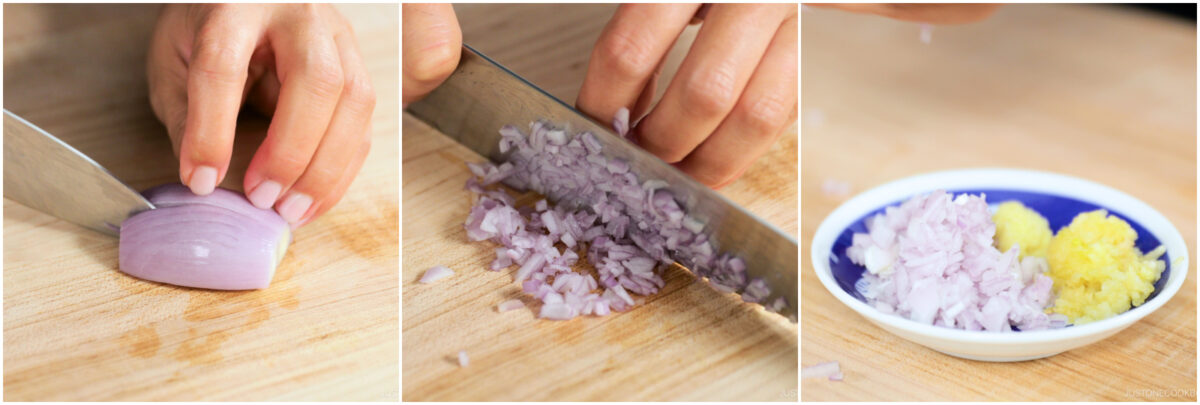
Grind 1 Tbsp toasted white sesame seeds, leaving some unground for texture. Set aside.
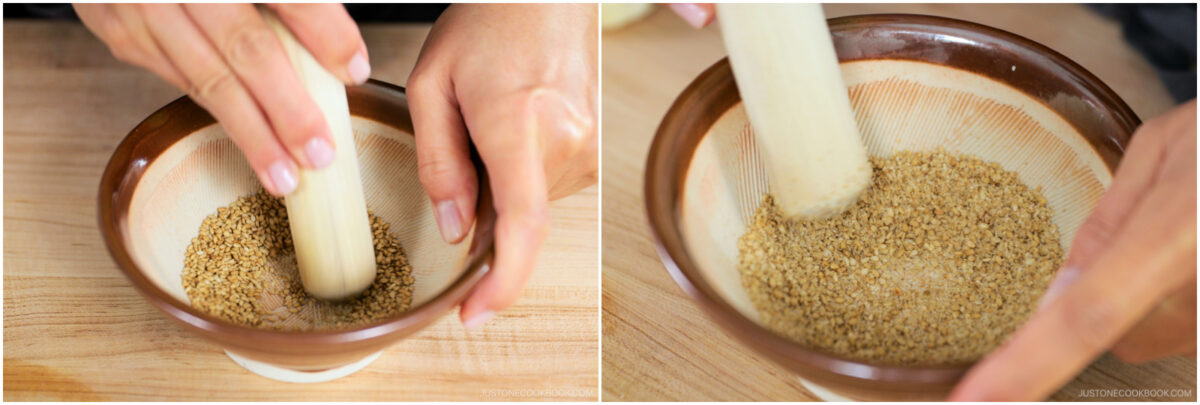
To Make the Soup Broth
Preheat a medium pot over medium-low heat. When it‘s hot, add 1 Tbsp toasted sesame oil and add the garlic, ginger, and shallot, and stir-fry with a wooden spatula until fragrant.
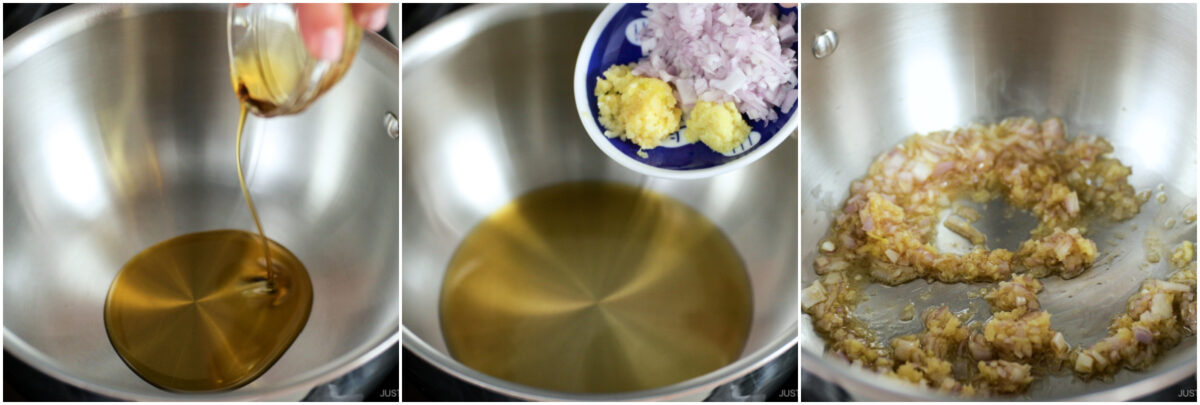
Add ¼ lb ground pork and increase to medium heat. Cook until the meat is no longer pink.
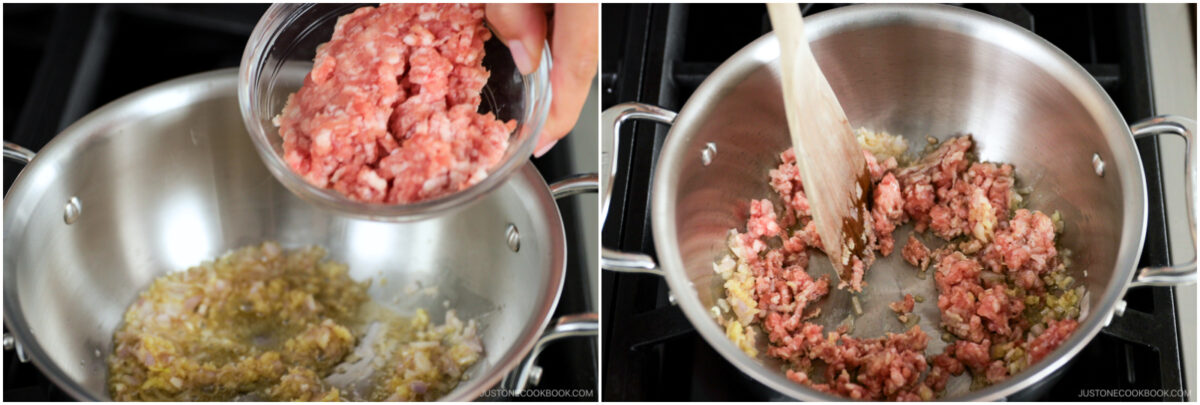
Add 1 tsp doubanjiang (spicy chili bean paste) and 3 Tbsp miso. Quickly blend with the meat without burning.
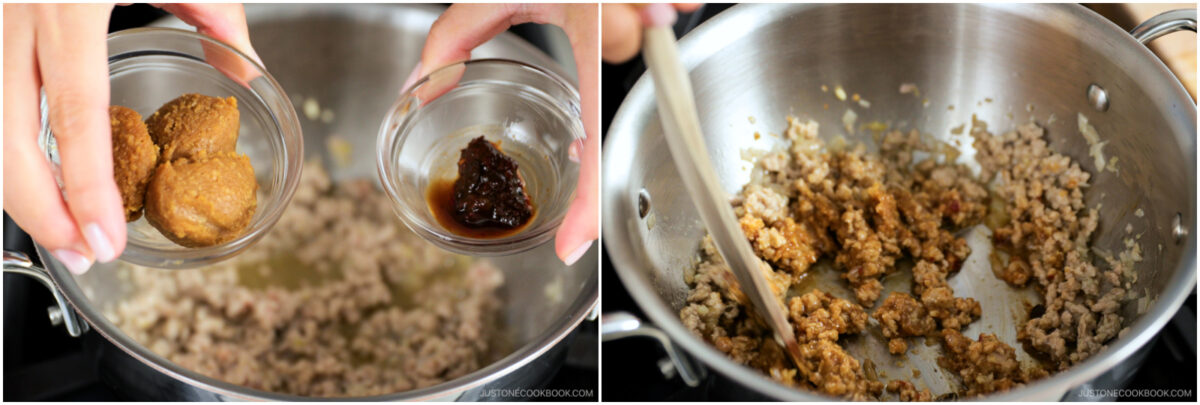
Add the ground sesame seeds and 1 Tbsp sugar and mix well.
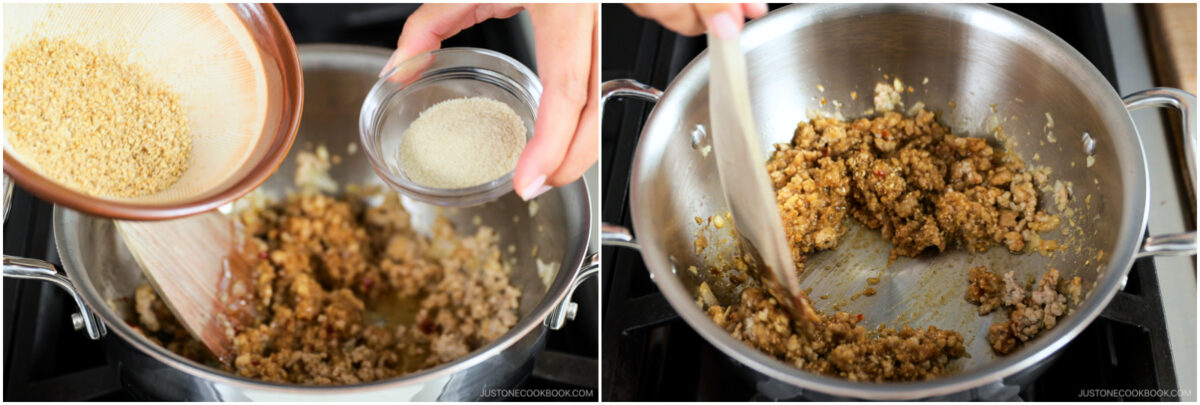
Add 1 Tbsp sake and 4 cups chicken stock/broth, and bring the mixture to a simmer.
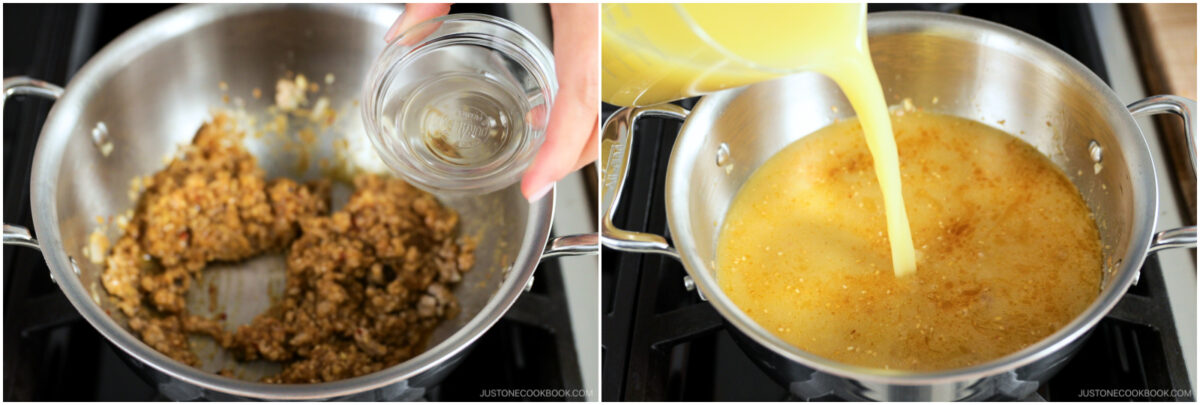
Taste and add up to 1 tsp Diamond Crystal kosher salt and ¼ tsp white pepper powder. Cover the soup broth with the lid and keep it on a low simmer while you cook the noodles.
Nami's Tip: Chicken stock varies in saltiness, so taste your soup to decide how much salt to add.
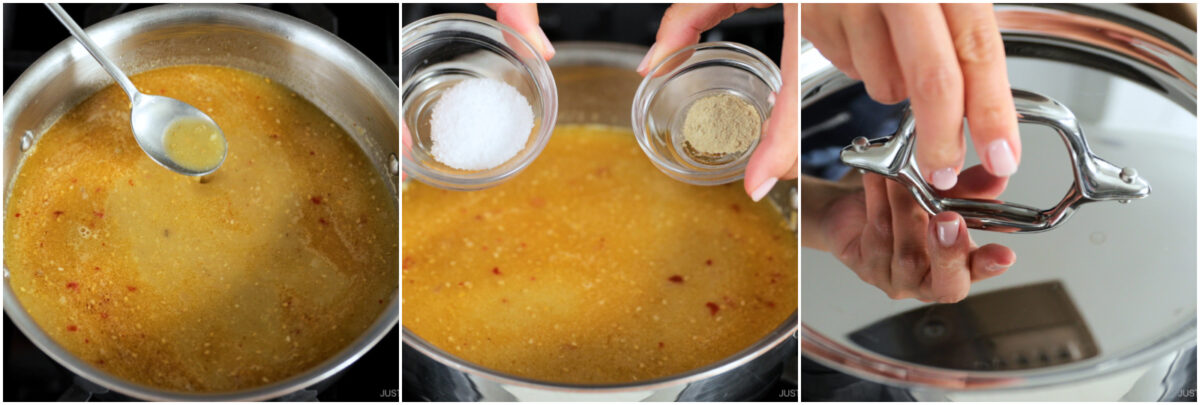
To Prepare the Ramen Noodles
Bring a large pot of unsalted water to a boil. When the water is boiling, ladle some of the hot water into the ramen bowls to warm them. Meanwhile, gently shake 2 servings fresh ramen noodles with your hand to separate and loosen them.
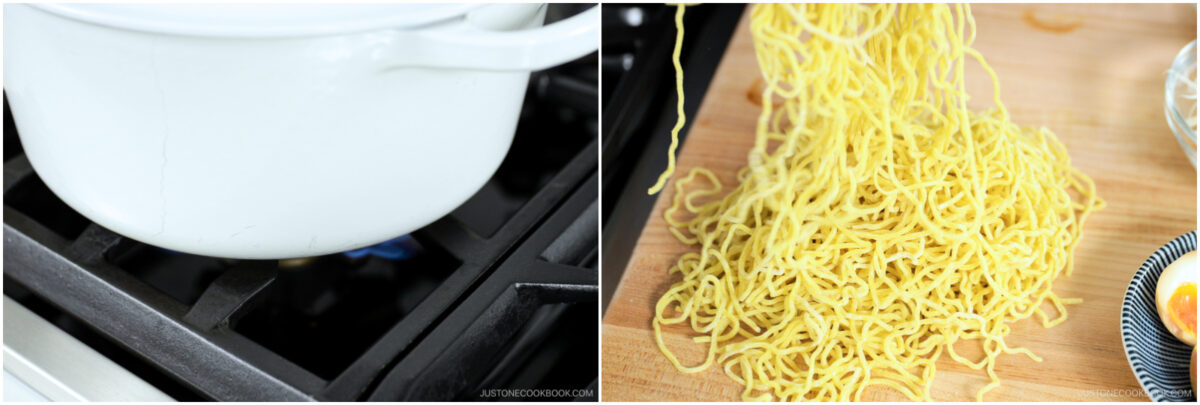
Cook the noodles according to the package instructions. I cook the noodles al dente so they're still firm, about 15 seconds less than the suggested cooking time. Before your noodles are done cooking, empty the hot water from the warmed ramen bowls.
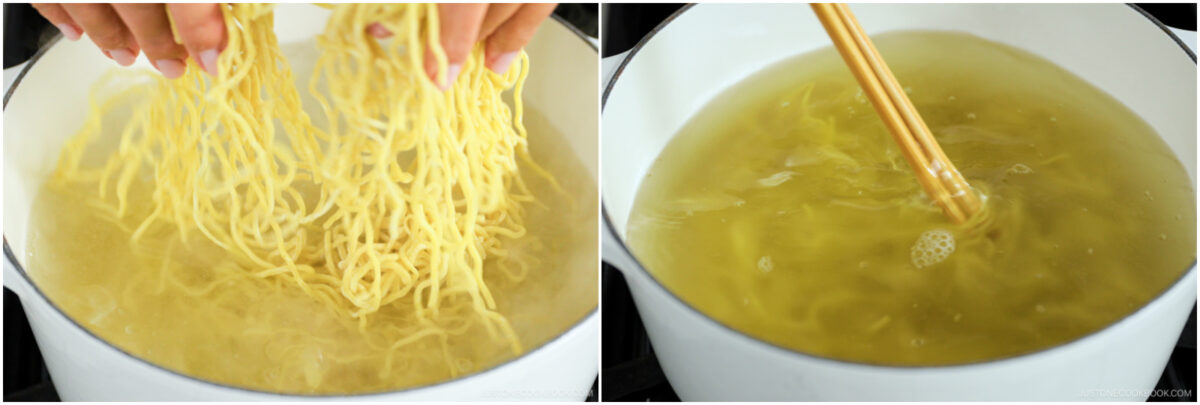
When the noodles are done, quickly pick them up with a mesh sieve and shake out the excess water. Serve them into the warmed bowls.
Nami's Tip: Drain the noodles well so the cooking water doesn't dilute your soup.
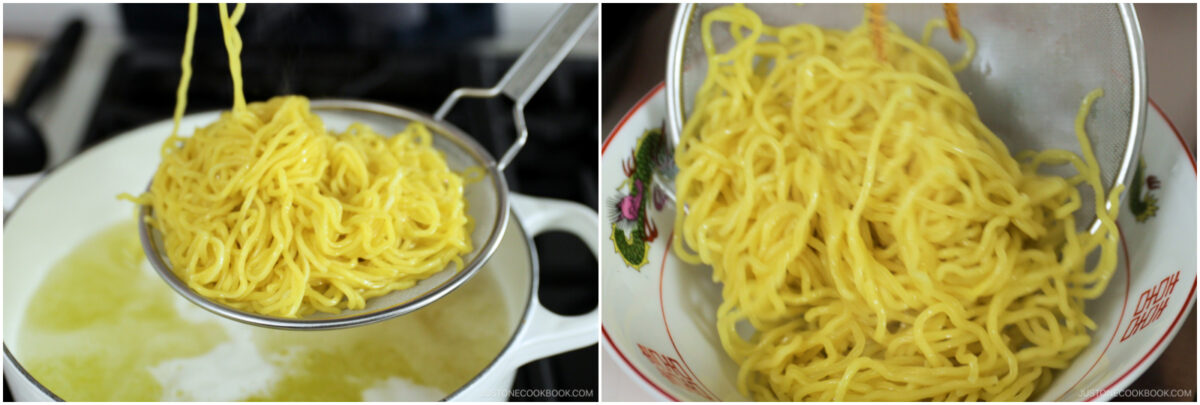
To Store
You can keep the soup broth in the refrigerator for 3 days. Cook the noodles right before serving.
Calories: 433kcal, Carbohydrates: 37g, Protein: 19g, Fat: 25g, Saturated Fat: 8g, Trans Fat: 1g, Cholesterol: 65mg, Sodium: 1216mg, Potassium: 341mg, Fiber: 4g, Sugar: 8g, Vitamin A: 112IU, Vitamin C: 4mg, Calcium: 152mg, Iron: 4mg
Did you make this recipe?
Tag @justonecookbook on Instagram so we can see your delicious creation!
Editor’s Note: This post was originally published in May 2011. It was updated with new photos and a video in September 2014, refreshed again in May 2019 and February 2022, and republished on October 19, 2025, with more helpful information.


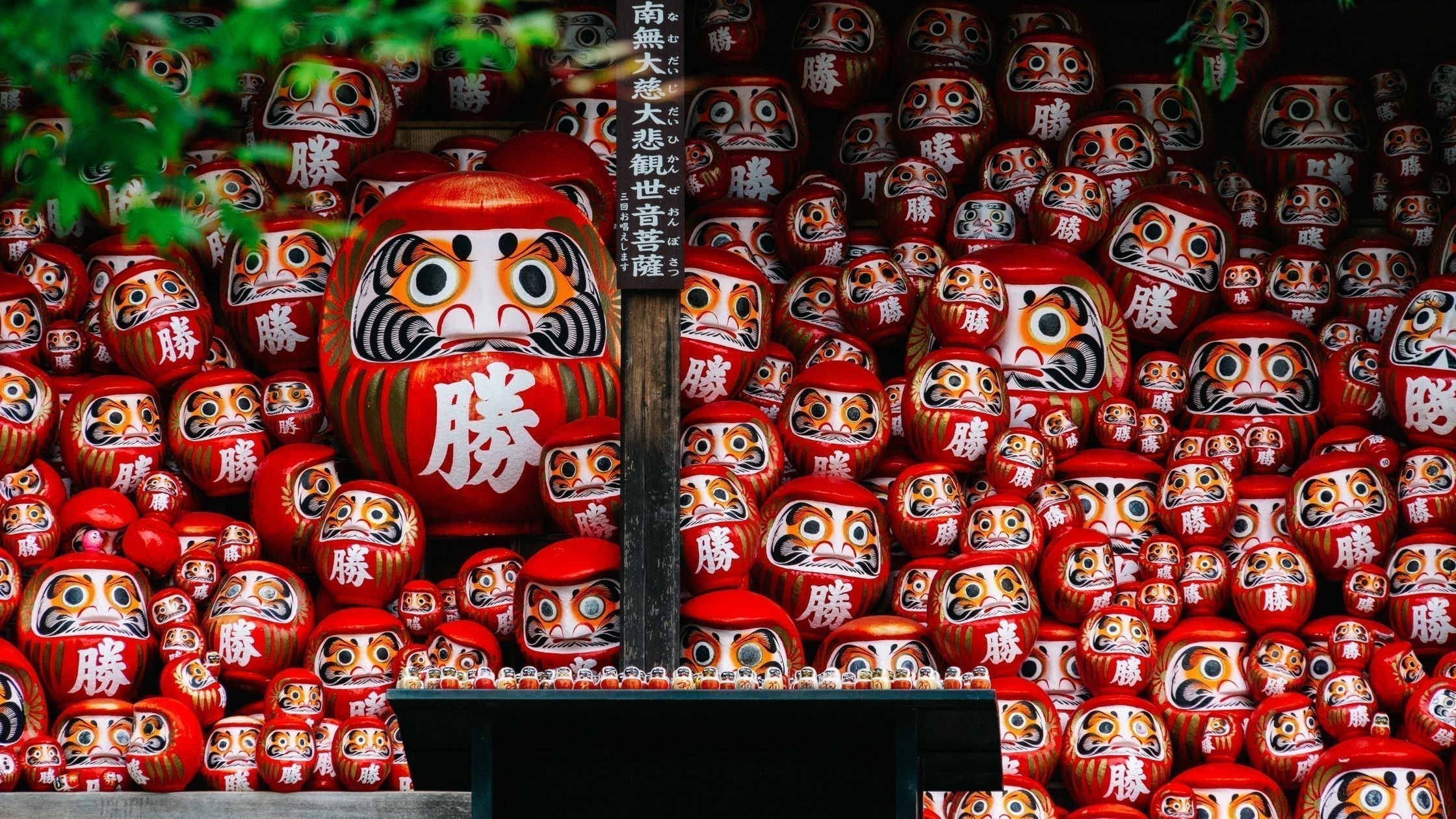








 English (US) ·
English (US) ·